Review of the Numerical Simulation of the Wind and Pollutant Diffusion in Urban Street Canyon under the Influence of Trees
Abstract
1. Introduction
2. Characterization of the Trees in an Urban Street Canyon by a Mathematical Model
| References | Energy Model | Turbulence Model | Leaf Model | Pollutant Framework | Software |
|---|---|---|---|---|---|
| [9,44] | Off | RANS | Source item | Euler | OpenFOAM |
| [45] | Off | LES | Source item | Euler | |
| [34] | Off | RANS | Solid | Euler | ANSYS Fluent |
| [46] | Off | RANS and LES | Source item | Euler | |
| [10,47,48,49] | Off | RSM | Source item | Euler | |
| [6] | Off | RSM and RANS | Source item | Euler | |
| [2,50,51,52] | Off | RANS | Source item | Euler | |
| [53] | On | RANS | Source item | Euler | |
| [54] | Off | LES | Source item | Euler | |
| [42] | Off | RANS | Solid | Lagrange | |
| [55] | On | RANS | Source item | Euler | STAR-CCM+ |
| [56,57] | Off | RANS | Source item | Euler | PHOENICS |
| [58] | Off | RANS | Source item | Euler | ENVI-met |
| [59] | Off | RANS | Source item | Euler | Fluidyn-PANACHE |
2.1. Porous Media Model
2.2. Vegetation Resistance Source Model
2.3. Model Validation
3. Characteristic Factors of Trees
3.1. Tree Branches
3.2. Tree Crown
3.3. Tree Layout
4. Street Canyon Morphology
5. Meteorological Factors
5.1. Thermal Environment
5.2. Wind Speed and Direction
6. Conclusions and Prospect
Author Contributions
Funding
Data Availability Statement
Conflicts of Interest
References
- Amorim, J.H.; Rodrigues, V.; Tavares, R.; Valente, J.; Borrego, C. CFD modelling of the aerodynamic effect of trees on urban air pollution dispersion. Sci. Total Environ. 2013, 461–462, 541–551. [Google Scholar] [CrossRef] [PubMed]
- Lin, J.; Kroll, C.N.; Nowak, D.J.; Greenfield, E.J. A review of urban forest modeling: Implications for management and future research. Urban For. Urban Gree. 2019, 43, 126366. [Google Scholar] [CrossRef]
- Abhijith, K.V.; Gokhale, S. Passive control potentials of trees and on-street parked cars in reduction of air pollution exposure in urban street canyons. Environ. Pollut. 2015, 204, 99–108. [Google Scholar] [CrossRef] [PubMed]
- Buccolieri, R.; Santiago, J.L.; Rivas, E. Review on urban tree modelling in CFD simulations: Aerodynamic, deposition and thermal effects. Urban For. Urban Gree. 2018, 31, 212–220. [Google Scholar] [CrossRef]
- Yang, H.Y.; Chen, T.H.; Lin, Y.Y.; Buccolieri, R.; Mattsson, M.; Zhang, M.; Hang, J.; Wang, Q. Integrated impacts of tree planting and street aspect ratios on CO dispersion and personal exposure in full-scale street canyons. Build. Environ. 2020, 169, 106529. [Google Scholar] [CrossRef]
- Zhou, S.W.; Tang, R.L.; Zhang, Y.X.; Ma, K.M. Simulation study on the influence of green belt settings on air-flow and pollution distribution in street canyon. Acta Ecol. Sin. 2018, 38, 6348–6357. (In Chinese) [Google Scholar]
- Gromke, C.; Buccolieri, R.; Sabatino, S.D.; Ruck, B. Dispersion study in a street canyon with tree planting by means of wind tunnel and numerical investigations evaluation of CFD data with experimental data. Atmos. Environ. 2008, 42, 8640–8650. [Google Scholar] [CrossRef]
- Gromke, C. A vegetation modeling concept for building and environmental aerodynamics wind tunnel tests and its application in pollutant dispersion studies. Environ. Pollut. 2011, 159, 2094–2099. [Google Scholar] [CrossRef]
- Mei, S.J.; Hu, J.T.; Liu, D.; Zhao, F.Y.; Li, Y.G.; Wang, H.Q. Airborne pollutant dilution inside the deep street canyons subjecting to thermal buoyancy driven flows: Effects of representative urban skylines. Build. Environ. 2019, 149, 592–606. [Google Scholar] [CrossRef]
- Jeanjean, A.P.R.; Buccolieri, R.; Eddy, J.; Monks, P.S. Air quality affected by trees in real street canyons: The case of Marylebone neighborhood in central London. Urban For. Urban Gree. 2017, 22, 41–53. [Google Scholar] [CrossRef]
- Huang, Y.D.; Li, M.Z.; Ren, S.Q.; Wang, M.J.; Cui, P.Y. Impacts of tree-planting pattern and trunk height on the airflow and pollutant dispersion inside a street canyon. Build. Environ. 2019, 165, 106385. [Google Scholar] [CrossRef]
- Ming, T.Z.; Fan, W.J.; Peng, C.; Cai, C.J.; Richeter, R.D.; Ahmadi, M.H.; Wen, Y.G. Impacts of traffic tidal flow on pollutant dispersion in a non-uniform urban street canyon. Atmosphere 2018, 9, 82. [Google Scholar] [CrossRef]
- Dou, H.W.; Ming, T.Z.; Xu, J.; Li, Z.T.; Cai, C.J.; Fang, W.J. Numerical simulation of pollutant propagation characteristics in a three-dimensional urban traffic system. China Environ. Sci. 2018, 38, 51–58. (In Chinese) [Google Scholar]
- Wang, Y.J.; Kang, Y.M.; Chen, Y.H. Influence of buildings and tree planting on air pollutants diffusion in street canyon. J. Donghua Univ. Nat. Sci. 2012, 38, 740–744. (In Chinese) [Google Scholar]
- Chen, T.H.; Pan, H.N.; Lu, M.R.; Hang, J.; Lam, C.K.C.; Yuan, C.; Pearlmutter, D. Effects of tree plantings and aspect ratios on pedestrian visual and thermal comfort using scaled outdoor experiments. Sci. Total Environ. 2021, 801, 149527. [Google Scholar] [CrossRef]
- Salmond, J.A.; Williams, D.E.; Laing, G.; Kingham, S.; Dirks, K.; Longley, I.; Henshaw, G.S. The influence of vegetation on the horizontal and vertical distribution of pollutants in a street canyon. Sci. Total Environ. 2013, 443, 287–298. [Google Scholar] [CrossRef] [PubMed]
- Ren, F.H.; Qiu, Z.W.; Liu, Z.; Bai, H.; Gao, H.O. Trees help reduce street-side air pollution: A focus on cyclist and pedestrian exposure risk. Build. Environ. 2023, 229, 109923. [Google Scholar] [CrossRef]
- Chen, T.; Yang, H.; Chen, G.; Lam, C.K.C.; Hang, J.; Wang, X.M.; Liu, Y.L.; Ling, H. Integrated impacts of tree planting and aspect ratios on thermal environment in street canyons by scaled outdoor experiments. Sci. Total Environ. 2021, 764, 142920. [Google Scholar] [CrossRef]
- Xiao, Q.K.; Cheng, Y.T.; Li, S.T.; Lin, Y.Y.; Cheng, W.J.; Wu, C.G. Research methods and progress on the reduction effects of vehicle emission pollutant by street canyon greening. Chin. J. Appl. Ecol. 2022, 33, 3127–3136. (In Chinese) [Google Scholar]
- Abhijith, K.V.; Kumar, P.; Gallagher, J.; McNabola, A.; Baldauf, R.; Pilla, F.; Broderick, B.; Sabatino, S.D.; Pulvirenti, B. Air pollution abatement performances of green infrastructure in open road and built-up street canyon environments—A review. Atmos. Environ. 2017, 162, 71–86. [Google Scholar] [CrossRef]
- Sara, J. Review on urban vegetation and particle air pollution—Deposition and dispersion. Atmos. Environ. 2015, 105, 130–137. [Google Scholar]
- Wang, L.; Zhang, Y.W.; Gu, Z.L. The numerical simulation of pollutant dispersion in street canyons under dynamic wind field and traffic flux conditions. China Environ. Sci. 2012, 32, 2161–2167. (In Chinese) [Google Scholar] [CrossRef]
- Wang, L.; Su, J.W.; Gu, Z.L.; Tang, L.Y. Numerical study on flow field and pollutant dispersion in an ideal street canyon within a real tree model at different wind velocities. Comput. Math. Appl. 2021, 81, 679–692. [Google Scholar] [CrossRef]
- Karttunen, S.; Kurppa, M.; Auvinen, M.; Hellsten, A.; Järvi, L. Large-eddy simulation of the optimal street-tree layout for pedestrian-level aerosol particle concentrations—A case study from a city-boulevard. Atmos. Environ. 2020, 6, 100073. [Google Scholar] [CrossRef]
- Gromke, C.; Blocken, B. Influence of avenue-trees on air quality at the urban neighborhood scale. Part II: Traffic pollutant concentrations at pedestrian level. Environ. Pollut. 2015, 196, 176–184. [Google Scholar] [CrossRef] [PubMed]
- Gromke, C.; Blocken, B. Influence of avenue-trees on air quality at the urban neighborhood scale. Part I: Quality assurance studies and turbulent Schmidt number analysis for RANS CFD simulations. Environ. Pollut. 2015, 196, 214–223. [Google Scholar] [CrossRef]
- Kang, G.; Kim, J.J.; Choi, W. Computational Fluid Dynamics Simulation of Tree Effects on Pedestrian Wind Comfort in an Urban Area. Sustain. Cities Soc. 2020, 56, 102086. [Google Scholar] [CrossRef]
- Wang, C.; Li, Q.; Wang, Z.H. Quantifying the impact of urban trees on passive pollutant dispersion using a coupled large-eddy simulation-Lagrangian stochastic model. Build. Environ. 2018, 145, 33–49. [Google Scholar] [CrossRef]
- OpenCFD, OpenFOAM. 2011. Available online: www.openfoam.com (accessed on 18 February 2023).
- ANSYS. ANSYS FLUENT 12.0 Theory Guide; ANSYS, Inc.: Canonsburg, PA, USA, 2009. [Google Scholar]
- CD-Adapco. User Guide, STAR-CCM+ Version 7.04; CD-Adapco: New York, NY, USA, 2013. [Google Scholar]
- Envi-Met. Envi-Met, Basics of Envi-Met Model in. 2018. Available online: https://www.envi-met.com/ (accessed on 18 February 2023).
- Pantusheva, M.; Mitkov, R.; Hristov, P.O.; Petrova-Antonova, D. Air Pollution Dispersion Modelling in Urban Environment Using CFD: A Systematic Review. Atmosphere 2022, 13, 1640. [Google Scholar] [CrossRef]
- Sun, J.; Zhang, Y. Influence of avenue trees on traffic pollutant dispersion in asymmetric street canyons: Numerical modeling with empirical analysis. Transport. Res. D 2018, 65, 784–795. [Google Scholar] [CrossRef]
- Luo, X.L.; Gu, Z.L. Study of aerosol dispersion in urban street canyon based on DPM model. J. Univ. Chin. Acad. Sci. 2007, 24, 578. (In Chinese) [Google Scholar]
- Tan, Z.; Dong, J.; Xiao, Y.; Tu, J.Y. Numerical simulation of diurnally varying thermal environment in a street canyon under haze-fog conditions. Atmos. Environ. 2015, 119, 95–106. [Google Scholar] [CrossRef]
- Zuo, L.; Zhou, T.; Xu, C.; Chen, S.; Chen, Y.; Liu, S.H. Research on PM10 diffusion and distribution of moving vehicle in street canyon based on dynamic mesh. Transport. Eng. 2022, 10, 100151. [Google Scholar] [CrossRef]
- Lu, K.F.; Peng, Z.R. Impacts of viaduct and geometry configurations on the distribution of traffic-related particulate matter in urban street canyon. Sci. Total Environ. 2023, 858, 159902. [Google Scholar] [CrossRef] [PubMed]
- Gallagher, J.; Baldauf, R.; Fuller, C.H.; Kumar, P.; Gill, L.W.; Mcnabola, A. Passive methods for improving air quality in the built environment: A review of porous and solid barriers. Atmos. Environ. 2015, 120, 61–70. [Google Scholar] [CrossRef]
- Su, J.W.; Wang, L.; Gu, Z.L.; Cao, Z.R. Effects of real trees and their structure on pollutant dispersion and flow field in an idealized street canyon. Atmos. Pollut. Res. 2019, 10, 1699–1710. [Google Scholar] [CrossRef]
- Wang, L.; Su, J.; Gu, Z.; Shui, Q.X. Effect of street canyon shape and tree layout on pollutant diffusion under real tree model. Sustainability 2020, 12, 2105. [Google Scholar] [CrossRef]
- Jeong, N.R.; Han, S.W.; Kim, J.H. Evaluation of vegetation configuration models for managing particulate matter along the urban street environment. Forests 2022, 13, 46. [Google Scholar] [CrossRef]
- Li, X.B.; Lu, Q.C.; Lu, S.J.; He, H.D.; Peng, Z.R.; Gao, Y.; Wang, Z.Y. The impacts of roadside vegetation barriers on the dispersion of gaseous traffic pollution in urban street canyons. Urban Forest. Urban Green. 2016, 17, 80–91. [Google Scholar] [CrossRef]
- Vranckx, S.; Vos, P.; Maiheu, B.; Janssen, S. Impact of trees on pollutant dispersion in street canyons: A numerical study of the annual average effects in Antwerp, Belgium. Sci. Total Environ. 2015, 532, 474–483. [Google Scholar] [CrossRef]
- McMullan, W.A.; Angelino, M. The effect of tree planting on traffic pollutant dispersion in an urban street canyon using large eddy simulation with a recycling and rescaling inflow generation method. J. Wind Eng. Ind. Aerod. 2022, 221, 104877. [Google Scholar] [CrossRef]
- Salim, S.M.; Cheah, S.C.; Chan, A. Numerical simulation of dispersion in urban street canyons with avenue-like tree plantings: Comparison between RANS and LES. Build. Environ. 2011, 46, 1735–1746. [Google Scholar] [CrossRef]
- Buccolieri, R.; Gromke, C.; Sabatino, S.D.; Ruck, B. Aerodynamic effects of trees on pollutant concentration in street canyons. Sci. Total Environ. 2009, 407, 5247–5256. [Google Scholar] [CrossRef] [PubMed]
- Zhang, L.; Zhang, Z.; McNulty, S.; Wang, P. The mitigation strategy of automobile generated fine particle pollutants by applying vegetation configuration in a street-canyon. J. Clean. Prod. 2020, 274, 122941. [Google Scholar] [CrossRef]
- Silvana, D.S.; Buccolieri, R.; Pappaccogli, G.; Leo, L.S. The effects of trees on micrometeorology in a real street canyon: Consequences for local air quality. Int. J. Environ. Pollut. 2015, 58, 100–111. [Google Scholar]
- Li, J.F.; Zhan, J.M.; Li, Y.S.; Wai, O.W.H. CO2 absorption/emission and aerodynamic effects of trees on the concentrations in a street canyon in Guangzhou, China. Environ. Pollut. 2013, 177, 4–12. [Google Scholar] [CrossRef]
- Ng, W.Y.; Chau, C.K. Evaluating the role of vegetation on the ventilation performance in isolated deep street canyons. J. Environ. Pollut. 2012, 50, 98–110. [Google Scholar] [CrossRef]
- Jin, X.; Yang, L.; Du, X.; Yang, Y.P. Transport characteristics of PM2.5 inside urban street canyons: The effects of trees and vehicles. Build. Simul. 2017, 10, 337–350. [Google Scholar] [CrossRef]
- Li, Z.T.; Zhang, H.; Juan, Y.H.; Lee, Y.T.; Wen, C.Y.; Yang, A.S. Effects of urban tree planting on thermal comfort and air quality in the street canyon in a subtropical climate. Sustain. Cities Soc. 2023, 91, 104334. [Google Scholar] [CrossRef]
- Moonen, P.; Gromke, C.; Dorer, V. Performance assessment of Large Eddy Simulation (LES) for modeling dispersion in an urban street canyon with tree planting. Atmos. Environ. 2013, 75, 66–76. [Google Scholar] [CrossRef]
- Hosseinzadeh, A.; Bottacin-Busolin, A.; Keshmiri, A. A parametric study on the effects of green roofs, green walls and trees on air quality, temperature and velocity. Buildings 2022, 12, 2159. [Google Scholar] [CrossRef]
- Hong, B.; Lin, B.R.; Qin, H.Q. Numerical Investigation on the effect of avenue trees on PM2.5 dispersion in urban street canyons. Atmosphere 2017, 8, 129. [Google Scholar] [CrossRef]
- Zhang, X.T.; Gao, Y.F.; Tao, Q.H.; Min, Y.R.; Fan, J.T. Improving the pedestrian-level wind comfort by lift-up factors of panel residence complex: Field-measurement and CFD simulation. Build. Environ. 2023, 229, 109947. [Google Scholar] [CrossRef]
- Peter, E.J.V.; Bino, M.H.; Jean, V.; Janssen, S. Improving local air quality in cities: To tree or not to tree? Environ. Pollut. 2013, 183, 113–122. [Google Scholar]
- Moradpour, M.; Hosseini, V. An investigation into the effects of green space on air quality of an urban area using CFD modeling. Urban Clim. 2020, 34, 100686. [Google Scholar] [CrossRef]
- Gromke, C.; Ruck, B. Pollutant concentrations in street canyons of different aspect ratio with avenues of trees for various wind directions. Bound-Lay. Meteorol. 2012, 144, 41–64. [Google Scholar] [CrossRef]
- Xu, W.J.; Xing, H.; Yu, Z. Effect of greenbelt on pollutant dispersion in street canyon. Environ. Sci. 2012, 33, 532–538. (In Chinese) [Google Scholar]
- Issakhov, A.; Tursynzhanova, A. Modeling of the effects of porous and solid barriers along the road from traffic emissions in idealized urban street canyons. Environ. Sci. Pollut. R. 2022, 29, 60759–60776. [Google Scholar] [CrossRef]
- Alibek, I.; Aliya, T.; Aizhan, A. Numerical study of air pollution exposure in idealized urban street canyons: Porous and solid barriers. Urban Clim. 2022, 43, 101112. [Google Scholar]
- Gromke, C.; Ruck, B. On the impact of trees on dispersion processes of traffic emissions in street canyons. Bound-Lay. Meteorol. 2009, 131, 19–34. [Google Scholar] [CrossRef]
- Gu, Z.; Zhang, Y.; Lei, K. Large eddy simulation of flow in a street canyon with tree planting under various atmospheric instability conditions. Sci. China Technol. Sci. 2010, 53, 1928–1937. [Google Scholar] [CrossRef]
- Wang, F.; Sun, B.; Zheng, X.; Ji, X. Impact of block spatial optimization and vegetation configuration on the reduction of PM2.5 concentrations: A roadmap towards green transformation and sustainable development. Sustainability 2022, 14, 11622. [Google Scholar] [CrossRef]
- Moradpour, M.; Afshin, H.; Farhanieh, B. A numerical investigation of reactive air pollutant dispersion in urban street canyons with tree planting. Atmos. Pollut. Res. 2017, 8, 253–266. [Google Scholar] [CrossRef]
- Chen, L.; Liu, C.; Zhang, L.; Zou, R.; Zhang, Z. Variation in tree species ability to capture and retain airborne fine particulate matter (PM2.5). Sci. Rep. 2017, 7, 3206. [Google Scholar] [CrossRef] [PubMed]
- He, D.Y.; Li, Z.N. Wind tunnel test on wind-induced responses of roadside trees. J. Nat. Disasters 2019, 28, 44–53. (In Chinese) [Google Scholar]
- Franke, J.; Hellsten, A.; Schlünzen, H.; Carissimo, B. Best practice guideline for the CFD simulation of flows in the urban environment. In COST Action 732, Quality Assurance and Improvement of Microscale Meteorological Models; COST Office: Brussels, Belgium, 2007; p. 51. [Google Scholar]
- Defraeye, T.; Blocken, B.; Carmeliet, J. CFD analysis of convective heat transfer at the surfaces of a cube immersed in a turbulent boundary layer. Int. J. Heat Mass Tran. 2010, 53, 297–308. [Google Scholar] [CrossRef]
- Ramponi, R.; Blocken, B. CFD simulation of cross-ventilation for a generic isolated building: Impact of computational parameters. Build. Environ. 2012, 53, 34–48. [Google Scholar] [CrossRef]
- Qin, H.; Hong, B.; Huang, B.; Cui, X.; Zhang, T. How dynamic growth of avenue trees affects particulate matter dispersion: CFD simulations in street canyons. Sustain. Cities Soc. 2020, 61, 102331. [Google Scholar] [CrossRef]
- Endalew, A.M.; Hertog, M.; Gebrehiwot, M.G.; Baelmans, M.; Ramon, H.; Nicolaï, B.M.; Verboven, P. Modelling airflow within model plant canopies using an integrated approach. Comput. Electron. Agr. 2009, 66, 9–24. [Google Scholar] [CrossRef]
- Bai, K.L.; Katz, J.; Meneveau, C. Turbulent flow structure inside a canopy with complex multi-scale elements. Bound-Lay. Meteorol. 2015, 155, 435–457. [Google Scholar] [CrossRef]
- Troldborg, N.; Srensen, N.N.; Dellwik, E.; Hanggan, H. Immersed boundary method applied to flow past a tree skeleton. Agr. For. Meteorol. 2021, 308–309, 108603. [Google Scholar] [CrossRef]
- Wang, X.; Teng, M.; Huang, C.; Zhou, Z.X.; Chen, X.P.; Xiang, Y. Canopy density effects on particulate matter attenuation coefficients in street canyons during summer in the Wuhan metropolitan area. Atmos. Environ. 2020, 240, 117739. [Google Scholar] [CrossRef]
- Luo, X. Study on Measuring of Forest based on 3D Laser Scanning Measurement System. Ph.D. Thesis, Beijing Forestry University, Beijing, China, 2006. (In Chinese). [Google Scholar]
- Wang, L.; Tian, W.X.; Zhao, X.Y.; Cao, Z.R. Numerical simulation of the effects of canopy properties on airflow and pollutant dispersion in street canyons. Indoor Built Environ. 2022, 31, 466–478. [Google Scholar] [CrossRef]
- Hofman, J.; Bartholomeus, H.; Janssen, S.; Calders, K.; Wuyts, K.; Wittenberghe, S.V.; Samson, R. Influence of tree crown characteristics on the local PM10 distribution inside an urban street canyon in Antwerp (Belgium): A model and experimental approach. Urban For. Urban Gree. 2016, 20, 265–276. [Google Scholar] [CrossRef]
- Lin, D.; Shen, X.Y.; Zhu, Y.B.; Chen, C.C. Effect of spatial distribution of trees on the airflow at pedestrian breath height in the typical deep street canyon. J. Geo-Inf. Sci. 2018, 20, 1235–1243. (In Chinese) [Google Scholar]
- Cui, P.Y.; Zhang, Y.; Wang, M.J. Numerical investigation of the effect of green on the convective mass transfer in the street canyon. J. Eng. Thermophys. 2019, 40, 1648–1654. (In Chinese) [Google Scholar]
- Wu, J.; Chang, H.; Yoon, S. Numerical study on microclimate and outdoor thermal comfort of street canyon typology in extremely hot weather—A case study of busan, South Korea. Atmosphere 2022, 13, 307. [Google Scholar] [CrossRef]
- Moayedi, S.H.; Hassanzadeh, S. An LES study of aerodynamic effect of trees on traffic pollutant dispersion in an ideal street canyon. Eur. Phys. J. Plus 2022, 137, 797. [Google Scholar] [CrossRef]
- Zhang, L.; Zhang, Z.; Feng, C.; Tian, M.R.; Gao, Y.N. Impact of various vegetation configurations on traffic fine particle pollutants in a street canyon for different wind regimes. Sci. Total Environ. 2021, 789, 147960. [Google Scholar] [CrossRef]
- Lee, H.; Mayer, H. Solar elevation impact on the heat stress mitigation of pedestrians on tree-lined sidewalks of E-W street canyons—Analysis under Central European heat wave conditions. Urban For. Urban Gree. 2021, 58, 126905. [Google Scholar] [CrossRef]
- Lei, L.Q.; Cui, P.Y.; Huang, Y.D. Numerical simulation of the effect of street canyon shape on pollutant dispersion. J. Univ. Shanghai Sci. Technol. 2018, 40, 282–289. (In Chinese) [Google Scholar]
- Zhou, H.Y.; Kang, Y.M.; Yang, F.; Liu, G.L.; Zhong, K. Studies on the most unfavorable distance between the upstream building and the windward building in street canyons in urban area. China Environ. Sci. 2019, 10, 4125–4132. (In Chinese) [Google Scholar]
- Wang, L.; Pan, Q.; Zheng, X.P.; Yang, S.S. Effects of low boundary walls under dynamic inflow on flow field and pollutant dispersion in an idealized street canyon. Atmos. Pollut. Res. 2016, 8, 564–575. [Google Scholar] [CrossRef]
- Zhang, K.; Chen, G.; Wang, X.; Liu, S.H.; Mak, C.M.; Fan, Y.F.; Hang, J. Numerical evaluations of urban design technique to reduce vehicular personal intake fraction in deep street canyons. Sci. Total Environ. 2019, 653, 968–994. [Google Scholar] [CrossRef] [PubMed]
- Gu, Z.L.; Zhang, Y.W.; Cheng, Y.; Lee, S.C. Effect of uneven building layout on air flow and pollutant dispersion in non-uniform street canyons. Build. Environ. 2011, 46, 2657–2665. [Google Scholar] [CrossRef]
- Miao, C.P.; Li, P.P.; Yu, S.; Chen, W.; He, X.Y. Does street canyon morphology shape particulate matter reduction capacity by street trees in real urban environments? Urban For. Urban Gree. 2022, 78, 127762. [Google Scholar] [CrossRef]
- Buccolieri, R.; Jeanjean, A.; Gatto, E.; Leigh, R.J. The impact of trees on street ventilation, NO x and PM 2.5 concentrations across heights in Marylebone Rd street canyon, central London. Sustain. Cities Soc. 2018, 41, 227–241. [Google Scholar] [CrossRef]
- Li, W.; He, Y.; Zhang, Y.; Su, J.W.; Chen, C.G.; Yu, C.W.; Zhang, R.J.; Gu, Z.L. LES simulation of flow field and pollutant dispersion in a street canyon under time-varying inflows with TimeVarying-SIMPLE approach. Build. Environ. 2019, 157, 185–196. [Google Scholar] [CrossRef]
- Zhang, Y.W.; Gu, Z.L.; Duan, C.E.; Su, L.J. Numerical simulation on effect of moving vehicles on air flow and pollutant dispersion in urban street canyons. China Powder Sci. Technol. 2013, 19, 1–6. (In Chinese) [Google Scholar]
- Lin, Y.; Chen, G.; Chen, T.; Luo, Z.W.; Yuan, C.; Gao, P.; Hang, J. The influence of advertisement boards, street and source layouts on CO dispersion and building intake fraction in three-dimensional urban-like models. Build. Environ. 2019, 150, 297–321. [Google Scholar] [CrossRef]
- Su, J.W.; Wang, L.; Zhang, Y.W.; Gu, Z.L. The numerical simulation of pollutant dispersion in street canyon within noise barrier. Environ. Eng. 2016, 34, 92–97. (In Chinese) [Google Scholar]
- Coutts, A.M.; White, E.C.; Tapper, N.J.; Beringer, J.; Livesley, S.J. Temperature and human thermal comfort effects of street trees across three contrasting street canyon environments. Theor. Appl. Climatol. 2016, 124, 55–68. [Google Scholar] [CrossRef]
- Rahman, M.A.; Moser, A.; Gold, A.; Rötzer, T.; Pauleit, S. Vertical air temperature gradients under the shade of two contrasting urban tree species during different types of summer days. Sci. Total Environ. 2018, 633, 100–111. [Google Scholar] [CrossRef] [PubMed]
- Rahman, M.A.; Moser, A.; Rötzer, T.; Pauleit, S. Within canopy temperature differences and cooling ability of Tilia cordata, trees grown in urban conditions. Build. Environ. 2017, 114, 118–128. [Google Scholar] [CrossRef]
- Morakinyo, T.E.; Kong, L.; Lau, K.L.; Yuan, C.; Ng, E. A study on the impact of shadow-cast and tree species on in-canyon and neighborhood’s thermal comfort. Build. Environ. 2017, 115, 1–17. [Google Scholar] [CrossRef]
- Zhou, Y.C.; Fu, H.M.; Yang, H. Numerical simulation and evaluation of flow field of the street canyon with plans. J. DongHua Univ. (Nat. Sci.) 2016, 42, 419–425. (In Chinese) [Google Scholar]
- Gromke, C.; Ruck, B. Aerodynamic modelling of trees for small-scale wind tunnel studies. Forestry 2008, 81, 243–258. [Google Scholar] [CrossRef]
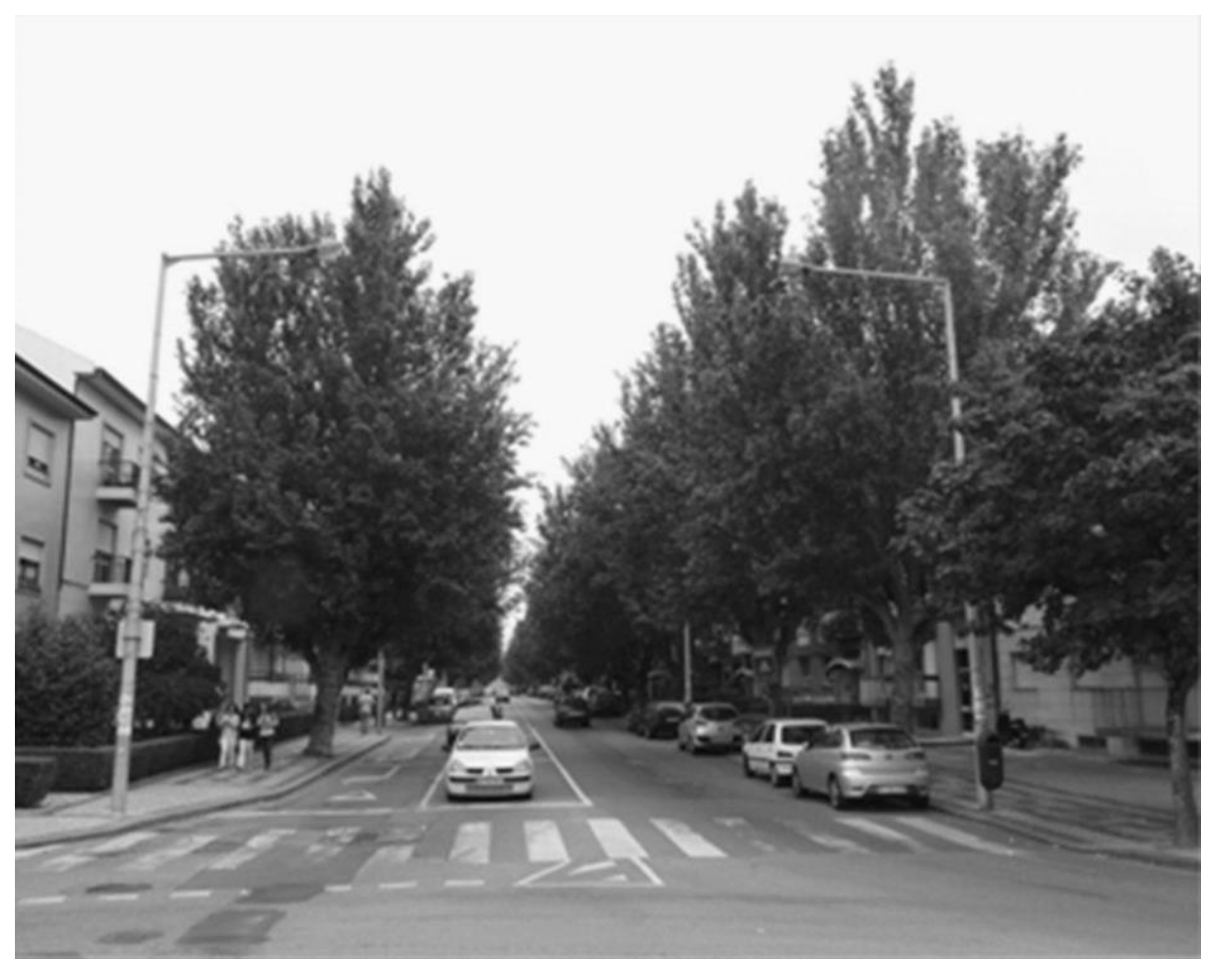
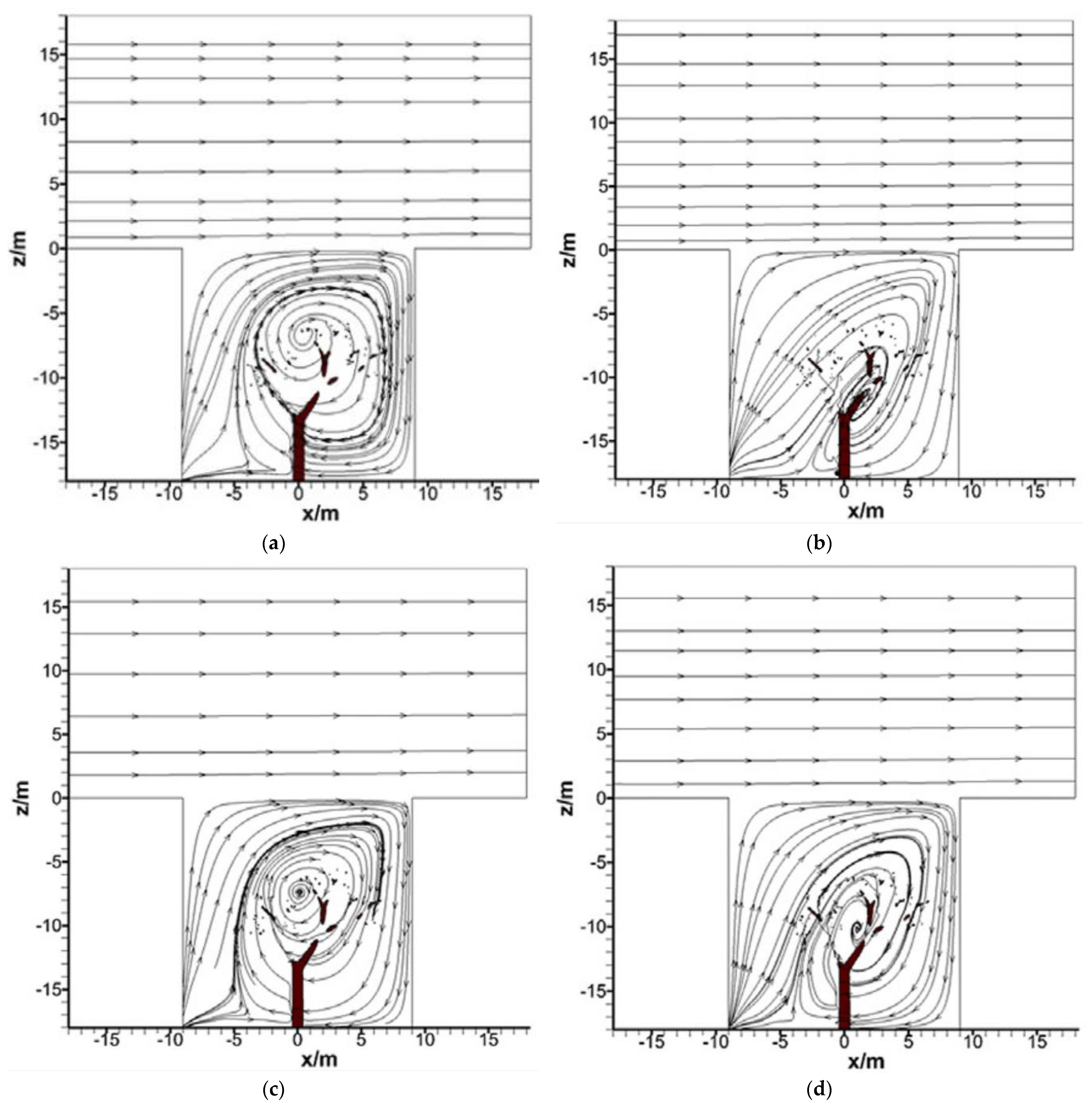

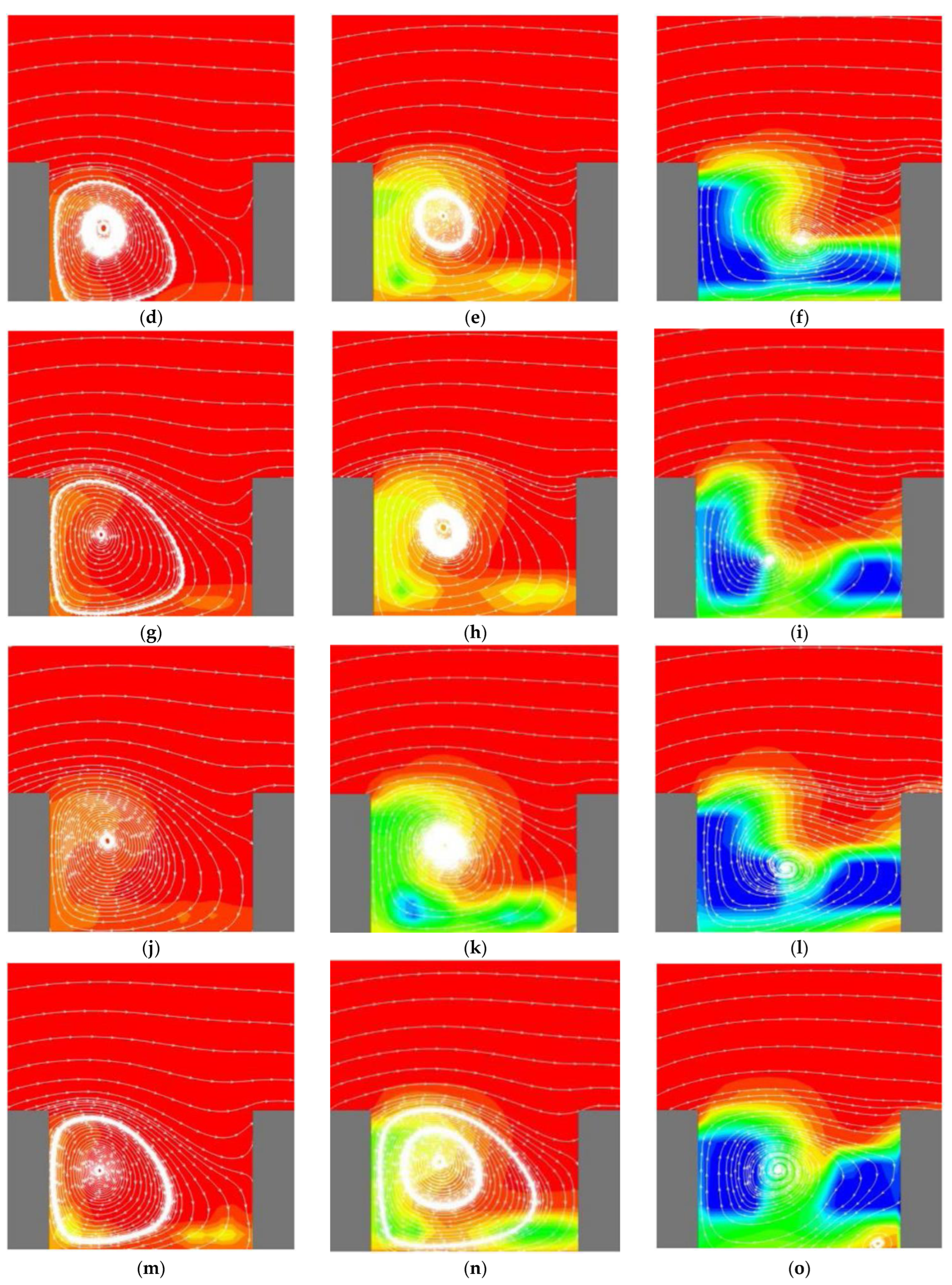

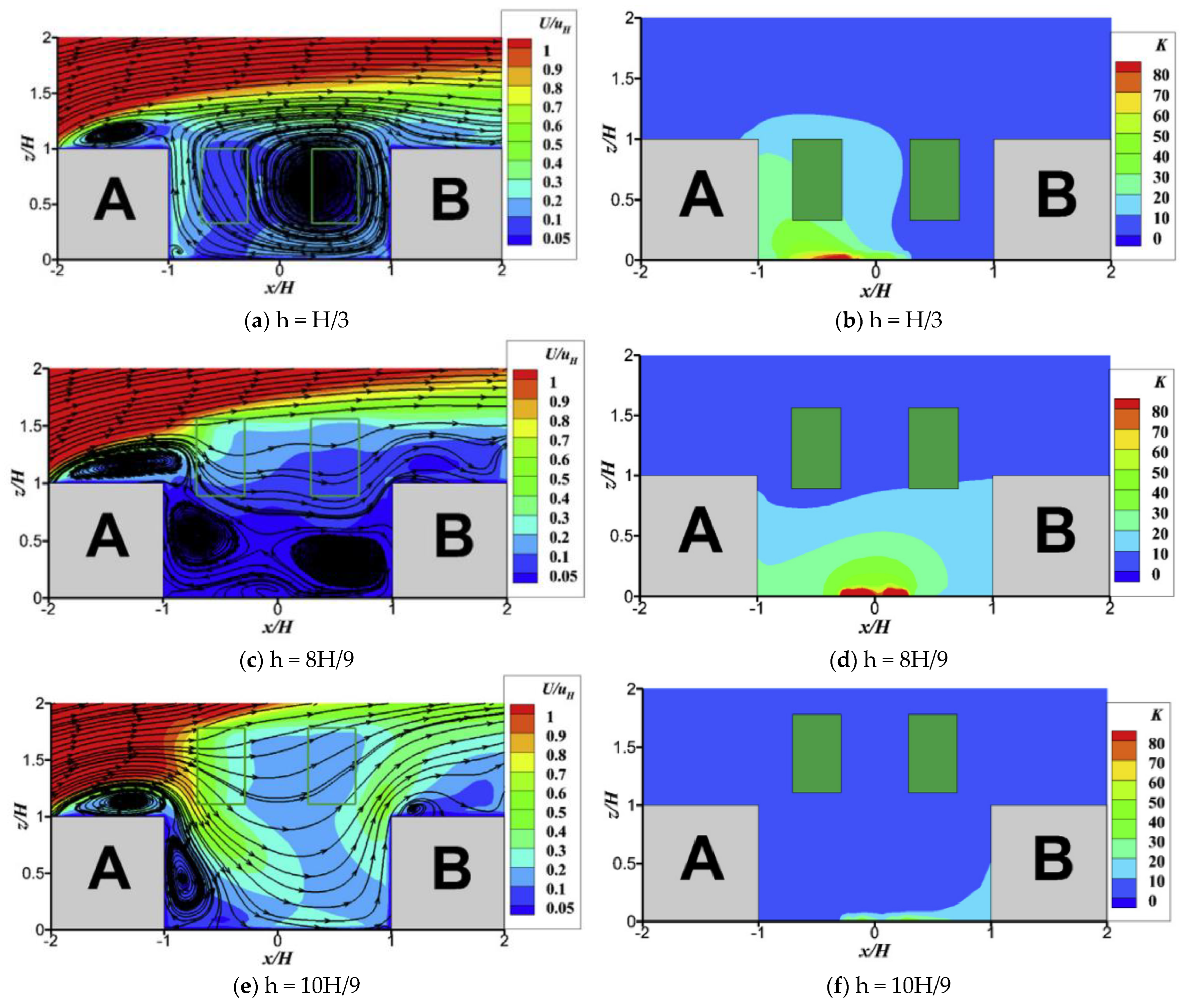
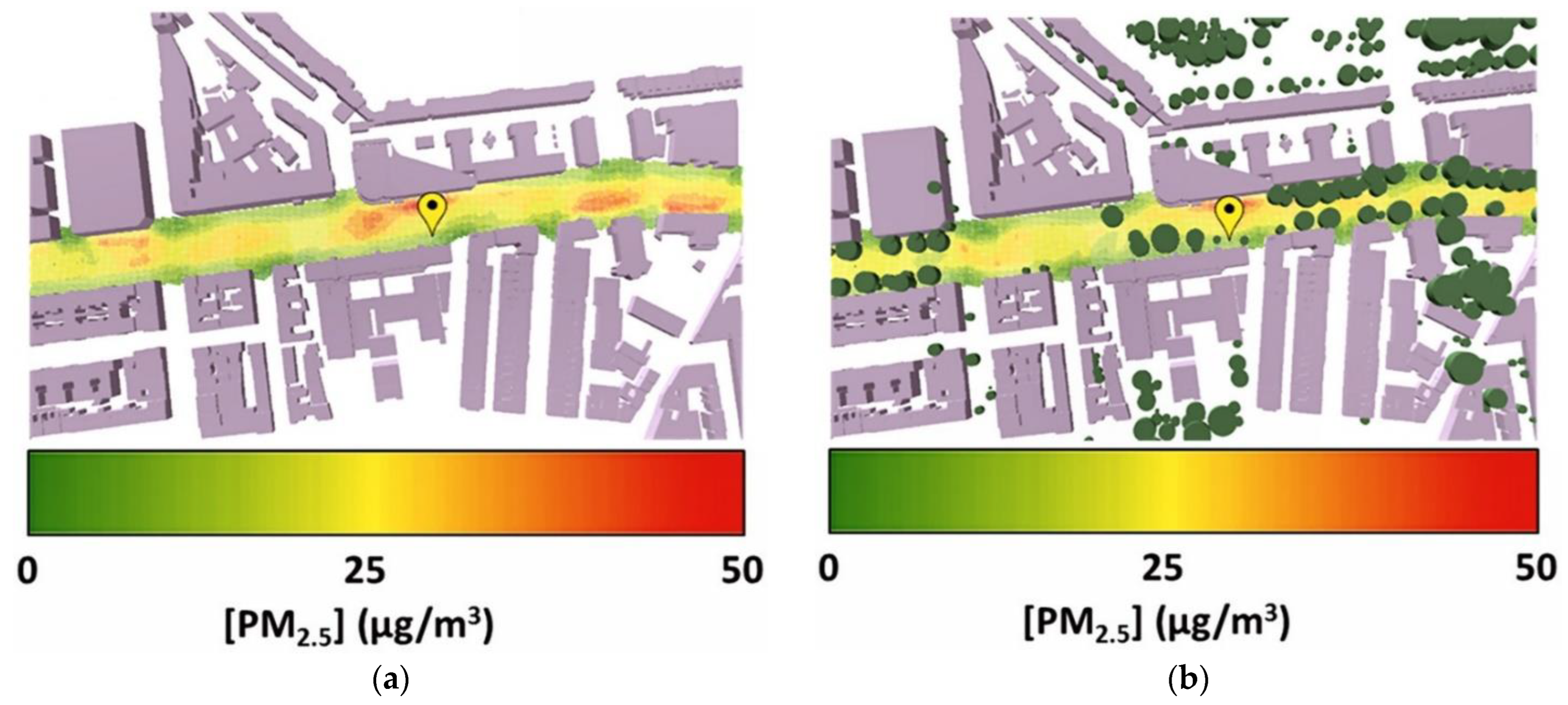
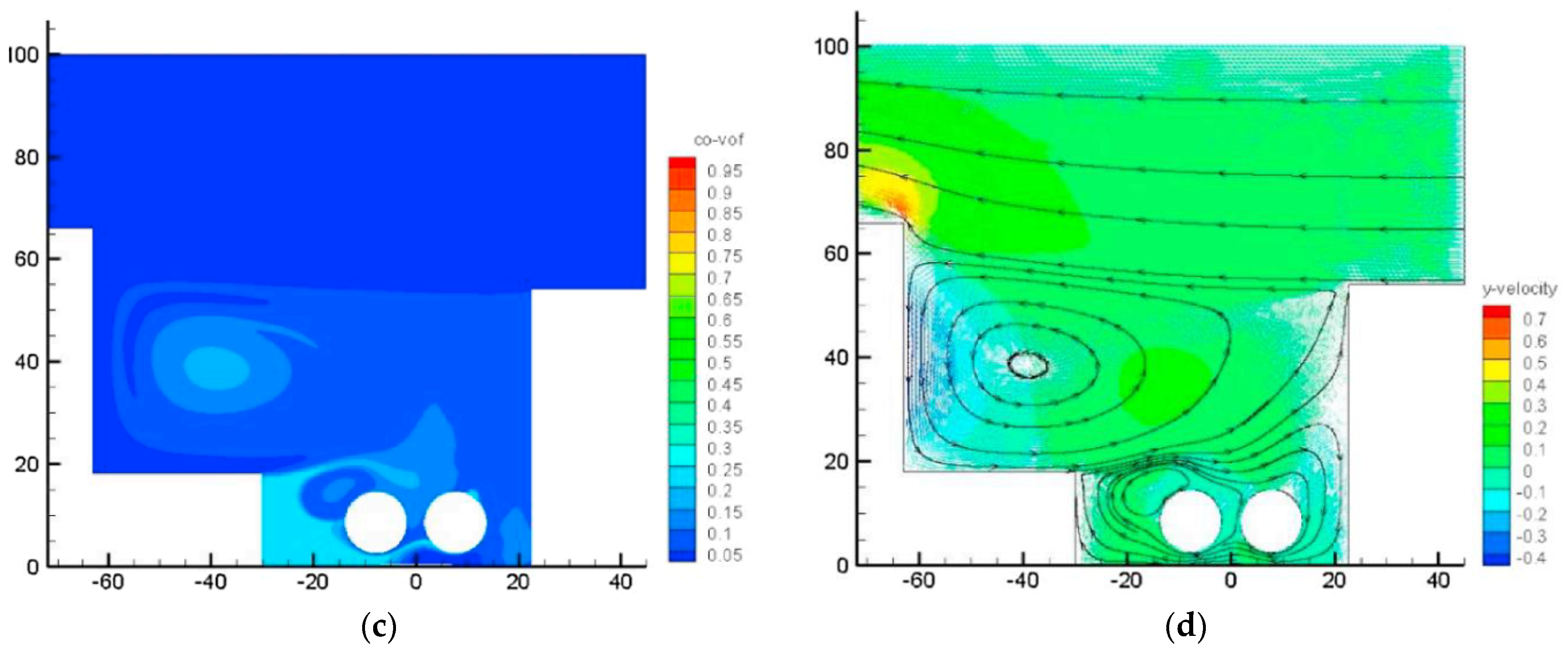
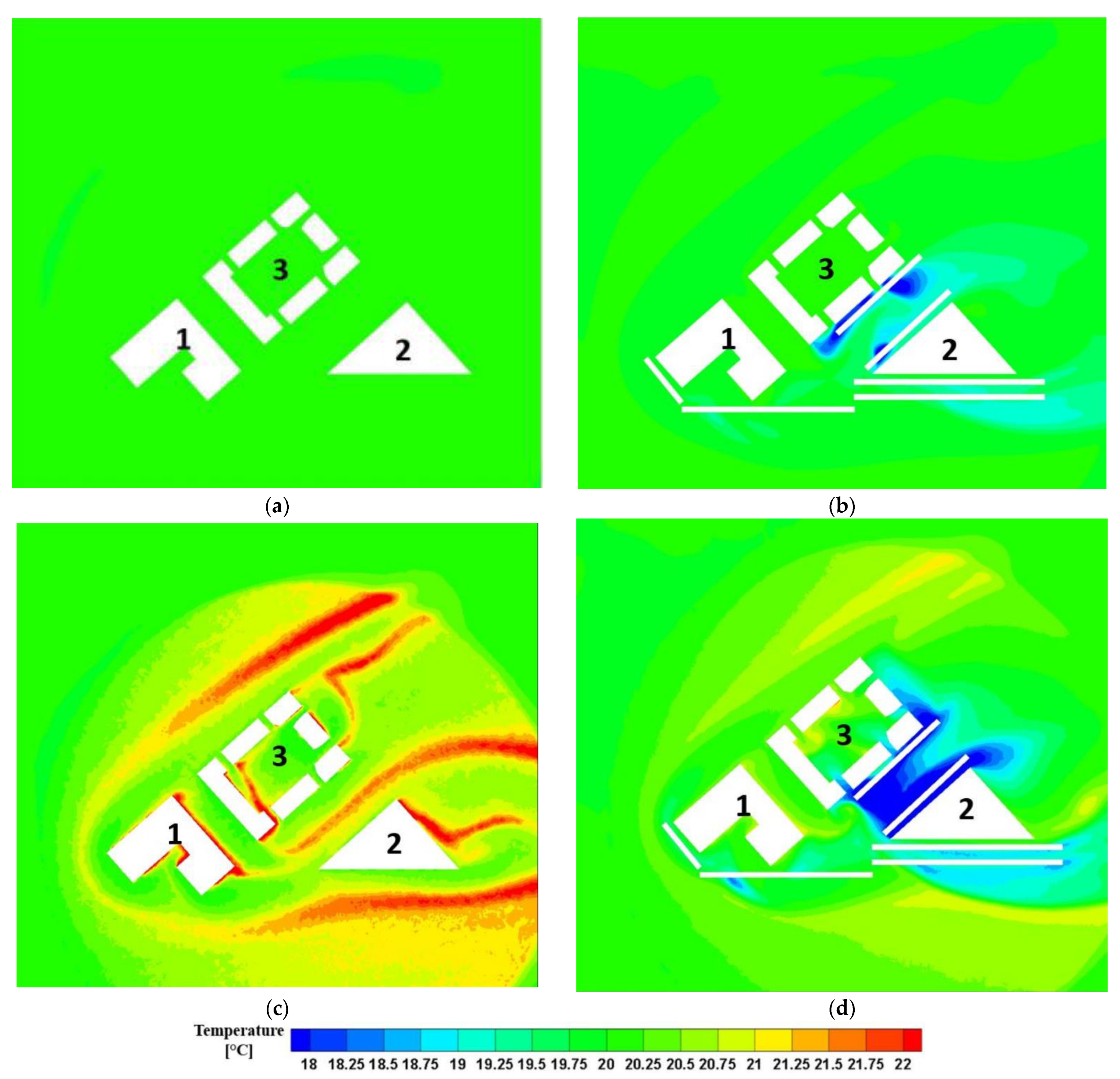
| References | Tree Trunk | Crown Shape | Tree Layout 1 | LAD (m2 m−3) | Tree Continuous |
|---|---|---|---|---|---|
| [10] | Off | Abnormal | Random | 1.6, 1.06 | Continuity/discontinuity |
| [11] | Off | Rectangle | SW/DW | - | Continuity |
| [5] | Off | Rectangle | DW | 0.5, 1, 2 | Continuity/discontinuity |
| [23,41] | On | - | SW/DW | - | - |
| [25,26] | Off | Rectangle | SW | 1.0 | Continuity/discontinuity |
| [27] | Off | Abnormal | Random | 0.85 | Continuity/discontinuity |
| [65] | Off | Rectangle | DW | LAD profile | Continuity |
| [56] | Off | Triangle, circular, rectangle | DW | 0.5, 1.5, 2.5 | Continuity |
| [73] | Off | Cone, expanded paraboloid, spheroid | DW | LAD profile | Discontinuity |
| [48] | Off | Rectangle | SW/DW | 0.5, 1, 2 | Continuity |
Disclaimer/Publisher’s Note: The statements, opinions and data contained in all publications are solely those of the individual author(s) and contributor(s) and not of MDPI and/or the editor(s). MDPI and/or the editor(s) disclaim responsibility for any injury to people or property resulting from any ideas, methods, instructions or products referred to in the content. |
© 2023 by the authors. Licensee MDPI, Basel, Switzerland. This article is an open access article distributed under the terms and conditions of the Creative Commons Attribution (CC BY) license (https://creativecommons.org/licenses/by/4.0/).
Share and Cite
Wang, L.; Tian, W.; Zheng, P. Review of the Numerical Simulation of the Wind and Pollutant Diffusion in Urban Street Canyon under the Influence of Trees. Buildings 2023, 13, 1088. https://doi.org/10.3390/buildings13041088
Wang L, Tian W, Zheng P. Review of the Numerical Simulation of the Wind and Pollutant Diffusion in Urban Street Canyon under the Influence of Trees. Buildings. 2023; 13(4):1088. https://doi.org/10.3390/buildings13041088
Chicago/Turabian StyleWang, Le, Wenxin Tian, and Peilin Zheng. 2023. "Review of the Numerical Simulation of the Wind and Pollutant Diffusion in Urban Street Canyon under the Influence of Trees" Buildings 13, no. 4: 1088. https://doi.org/10.3390/buildings13041088
APA StyleWang, L., Tian, W., & Zheng, P. (2023). Review of the Numerical Simulation of the Wind and Pollutant Diffusion in Urban Street Canyon under the Influence of Trees. Buildings, 13(4), 1088. https://doi.org/10.3390/buildings13041088






